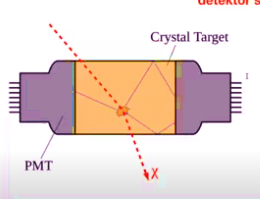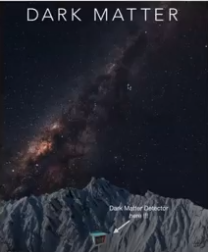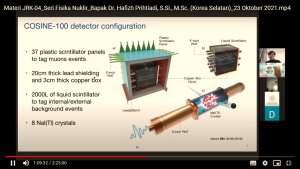Hello, physicist!
Jendela Rumah Kita is an ongoing event organized by Physics Department Diponegoro University and is a Teaching Physics Alumni program in facilitating physics students in particular to look at history and gain knowledge through the stories of great speakers from alumni and other great figures.
Jendela Rumah Kita series 4 invites great alumni in the field of research and technology, namely about Research Physics Of Dark Matter Mystery Experiments and Scholarships and further study opportunities in South Korea!
About Source
Hafizh Prihtiadi was born in Semarang on April 8, 1988. He was an alumnus of Diponegoro University physics in 2011. One of his career experiences is to become a Postdoctoral Research Fellow at the Center for Underground Physics Institute for Basic Science Korea, South korea and there are many research activities that he carries out. His expertise is especially in the field of Instrumentation and Electronics.
Physics Research Experiments Mystery of Dark Matter“Dark Matter”
Korean Goverment-Funded Research Institute that conducts basic science research and purely relevant basic research. IBS was founded in November 2011. There are 30 Research Centers (6 in Chemistry, 6 in life Science, 5 in interdisciplinary science, 10 in physics, 1 in Earth Science, 2 in Mathemetics).
The Center for Underground (CUP) founded in 2013 aims to conduct basic research beyond standard physics models to deepen our understanding of the origin and structure of the Universe.
Basic Knowledge
Science developed and corrected previous theories, all related to the subatomic particles and intercations explained through the standard models of particle physics. Astroparticle physics and experiments are branches of particle physics that study elementary particles and their relationship with astrophysicsand cosmology. The field is also a combination of particle physics, detectors, instrumentation and electronics. All things related to the subatomic particles and their interactions can be explained through the standard model of particle physics.
4 Fundamental forces in physics
- Gravitational force, which has not been found the carrier pertikel
- The electromagnetic carrier is a photon.
- Strong force “Strong” where the carrying particle is gluon
- Weak force “weak, particle carrier bosons (W, Z)
Standard Model of Element Particles

Use of Distillation Detectors in DARK MATTER COSINE-100 Research
Conceptually it can be detected directly and indirectly, therefore detectors are made assuming these particles exist all over the earth that directly inteksi with us. The hypothesis is that there is dark matter all around us. This experiment uses a distillation detector, as for the principle of work is to convert ionizing radiation that mashes the syntilator material into photons. Atomic atoms in the detector are stationary or stable, when particles hit the crystal atom there is kinetic energy between the particle and the atom. Particles will move giving rise to the presence of photons that will then be transmitted in the form of signals captured by the detector. But the detector must be stable(temperature humadity)and safe from environmental radiation (cosmic rays), therefore the detector needs to be placed underground.

Observing the universe, so the working principle of the COSINE-100 experiment is to design a detector planted within a depth of 700 m on a hill, then observed if any particles pass through the detector then there will be an observable caught signal called dark matter. This experiment is a collaboration of thei-ntitute that is operated in South Korea. There are 50 mentors in this dark matter collaboration.

He has two types of detectors in his experiments: the inside detector and the outside detector. This type of outside detector uses a plastic sentilator. Its usefulness is to detect the presence of muons in this case not being the object of research i.e. dark matter (outside). The inside is used copper box to protect gamma from environmental radiation. The core of the 8 NaI (Ti) crystal detector is its main function to detect dark matter.

PMT is used to convert photons into particles and sensors to capture photon light. The crystal will remove the photon and move towards the PMT and will be forwarded as a signal. For the monitoring system, more than 200 sensors are placed on each side of the detector so that it can be monitored for the stability of the detector and the existence of electrical breakouts.
After the monitored data is stored a lot of observable signals, therefore a collaboration is made from several institutes and their respective specialists.
Click the link below to see the full seminar video.

